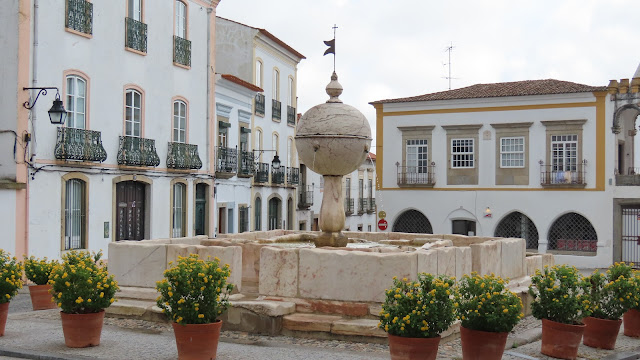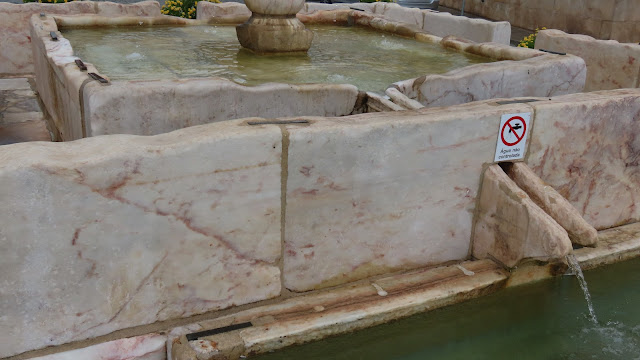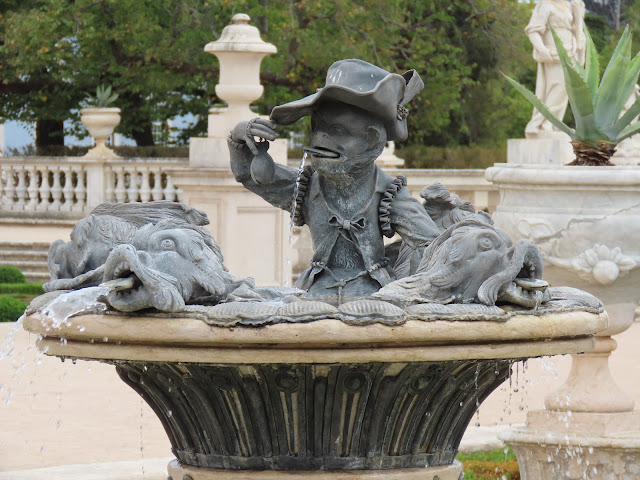Evora is at its heart an old walled city where the wall still exists and is a beautiful little town to spend a few days in. It's full of v narrow and windy streets which the locals still insist on driving cars down. Luckily the streets are one way as they are barely wide enough for a car and a pedestrian. Having said that it's a mystery why so many of the locals drive station wagons as turning a corner involves starting the turn, back up a bit, turn a bit more, back up a bit again and finally turn the corner.
Our couple of days here were marred slightly as Evora was clipped by the edge of Hurricane Danielle - just enough so that sudden downpours would occur about once an hour.
In the city's historic center stands the ancient Roman Temple to Diana and in the middle of the nearby municipal building the recently discovered (late 90s) roman baths - very cool.
The Porta de Moura fountain was built in the 1500's and, as its name would imply, near the entrance in the city walls. Over many centuries stock, horses etc would drink here and the necks, harnesses and/or hooves would rub on the walls of the fountain. So much so that over time wide grooves have been rubbed into the sides of the fountain.
Religion has a big part, ok sodding massive part, in Portuguese culture and cuisine.
In the late fifteenth century King Manuel of Portugal ordered all resident Jews to convert to Christianity or leave the country, something he didn't really want to happen for economic reasons so, when the deadline arrived, he announced that no ships were available for those who refused conversion. The unconverted were dragged to churches for a forced mass baptism. No great surprise that, most Jews maintained their religion secretly, but tried to show an image of being good Christians.
One way of doing this was by consuming a sausage, the Alheiras sausage, that looked like a pork sausage (but really only contained heavily spiced game and chicken). FYY - the Alheiras is quite tasty though very mushy.
Plus you can't really avoid getting hit with large doses of religion when sightseeing. With that said we checked out the Evora cathedral which is massive and highly impressive. The entry ticket included access to the bell tower and the roof with great views over the city (including the Aquaduct) and the museum (lots of religious artefacts and paintings).
The other big church we visited (again impressive building and museum with lots of religious artefacts, paintings and a small part of the Canha de Silva familys Nativity Scene collection - apparently their full collection is in excess of 3,600 Nativity Scenes) was Igreja de São Francisco.
Like a few cities of this era its water supply came from an aquaduct but what is amazing is that the Aquiduct still functions and still supplies some of the water to the city.
Decided to treat ourselves and have dinner at Catuxi Enocarta where the menu is tapas-like with small about $9, medium about $20, large about $30 and deserts at about $9. Plus with each dish there is a recommended glass of wine which varies from $5 to $25.
We opted for 2 small, 2 medium and 2 deserts with matching wines walked out stuffed and paid about the same as we would have on an average meal out in NZ. The dishes we had were fish soup, gazpacho with skewered "whitebait", braised octopus, slow cooked pig cheek, olive oil flan with olives and orange salad and Touchino do Ceu (egg mousse with ginger and lemon cream).
Did a tour out to see some nearby Megaliths and a dolmen (standing stones and a barrow) that date back about 5,500 years ago and was guided by an extremely knowledgeable and enthusiastic guide - so much so that we ended up visiting the Evora Museum just to see the artefacts recovered from the dolman that she described. The Megaliths were in an area where cork is regularly harvested hence lots of trees where the number is
The last digital of the year they were harvested.
Dinner on our last night in Evora was at a burger joint. Now Francesinha is the Portuguese version of a Croque-Monsieur and basically is a sarnie with beef, spicy sausage topped with cheese and a beer sauce.
The is the burger version of a Francesinha with a soft fried egg on top, and the pattie was served pink (so much so 50% of kiwis would probably send it back). V tasty.
























































